OR/15/034 Introduction: Difference between revisions
m 1 revision imported |
|
(No difference)
| |
Latest revision as of 15:23, 26 February 2016
| Alan W P Thomson (editor), Ciarán Beggan, Ellen Clarke, Simon Flower, Brian Hamilton, Gemma Kelly, Sarah Reay, Tony Swan, Alan Thomson, Chris Turbitt (contributors). 2015. Geomagnetism review 2014. British Geological Survey Internal Report, OR/15/034. |
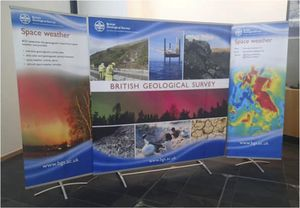
The Geomagnetism team
The Geomagnetism team measures, records, models and interprets variations in the Earth’s magnetic field. Our data and research help to develop scientific understanding of the evolution of the solid Earth and its atmospheric, ocean and space environments, and help develop our understanding of the geomagnetic hazard and its impact. We also provide geomagnetic products and services to industry and academics and we use our knowledge to inform the public, government and industry.
The British Geological Survey (BGS) is the main Earth science research facility for the UK and is a research centre of the Natural Environment Research Council (NERC).
Geomagnetism research is represented in BGS as a science team within the Earth Hazards and Observatories (EHO) science theme. The Geomagnetism, Earthquake Seismology, Earth and Planetary Observation and Monitoring and Volcanology teams join the Space Geodesy, British Isles Continuous GNSS and Geophysical Equipment Facilities, as parts of EHO.
EHO, in turn, is one of twelve BGS science themes that deliver the BGS science strategy. EHO is within the Geohazards programme and reports to the Director of Science and Technology and the BGS Executive.
The Geomagnetism team receives support from a range of BGS administrative and other teams, including Edinburgh Business Support and Systems and Network Support.
The Geomagnetism team is primarily based in Edinburgh. In 2014 the team numbered 25 staff either fully or partly engaged in Geomagnetism work.
For the purposes of continuous geomagnetic monitoring in the UK BGS operates three magnetic observatories. These are located in Lerwick (Shetland), at Eskdalemuir (Scottish Borders) and in Hartland (North Devon).
We also operate magnetic observatories overseas on Ascension Island, on Sable Island (Canada), at Port Stanley (Falkland Islands) and at King Edward Point (South Georgia). We oversee and maintain magnetic observatory operations at Prudhoe Bay, Alaska (USA) and are in the process of commissioning a new observatory at Fort McMurray in Alberta (Canada) in association with an industry partner.
Our observatory work and the data we collect is one part of our core function:
- Long-term geomagnetic monitoring and allied research to improve our understanding of the Earth and its geomagnetic processes, environments and hazards
Particular activities of the team are mathematical modelling of the geomagnetic field and its changes, monitoring and modelling of the geomagnetic (space weather) hazard to technology and the provision of information, data and products for the benefit of society.
In support of our core function, the team has four primary aims.
We aim to be a world leader in:
- Measuring, recording, modelling and interpreting the Earth’s natural magnetic field and its sources
- Modelling and understanding the geomagnetic hazard, a component of the space weather hazard to society’s technologies
- Delivering tailored geomagnetic data, products and services to academics, business and the public
- Knowledge and information for all sectors of society on geomagnetism science: what it tells us about the Earth and how it can be used in practical ways
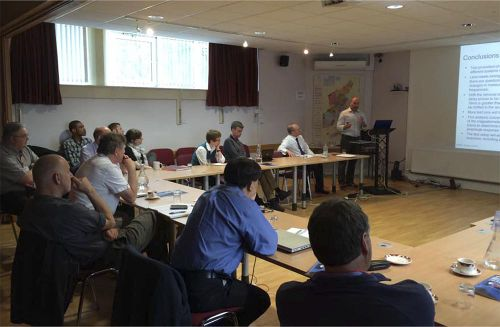
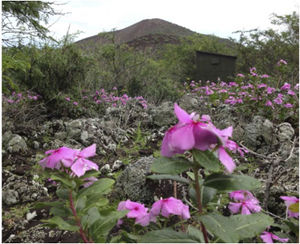
Looking ahead to 2015
In 2015 our research will focus on the space weather hazard to technology and infrastructure and the ESA Swarm magnetic survey mission. Our major activities to support this will include the operation of the BGS magnetic observatories and the UK magnetic survey to international standards. We will also produce academic and other geomagnetic models and data products.
Key objectives
The Geomagnetism team will continue to meet the aims of the current BGS and NERC strategies by means of the following objectives:
- Geomagnetic monitoring and modelling of the shallow and deep Earth and of the Earth’s space environment
- Applying our data, models and expertise in services and research for academia, industry and society
Main deliverables
Our specific deliverables for 2015 will be:
- An INTERMAGNET-standard (www.intermagnet.org) UK and overseas observatory network, obtained through regular observatory service visits and high-standard quality assurance procedures
- Full commissioning of the new Fort McMurray magnetic observatory in Alberta, Canada
- Supply of observatory data and products to INTERMAGNET, according to the timetable set by the INTERMAGNET organisation
- An annual re-survey of sites in the UK magnetic repeat station network, leading to production of the 2015 national magnetic model and delivery of a report to Ordnance Survey
- Publication of our observatory data and data products online and in the Monthly Bulletins series
- Supply of magnetic index products to the International Service for Geomagnetic Indices (ISGI), according to the timetable set by ISGI
- Operation of the World Data Centre for Geomagnetism (Edinburgh), including an annual ‘call for data’ and associated quality control activities
- Collaboration on existing international geomagnetic observatory (INDIGO) and survey programmes (MagNetE)
- Active participation (through presentations and organisation of sessions) in a number of major international scientific conferences, e.g. the UK National Astronomy Meeting, the 12th European Space Weather Week and the IUGG congress, Prague.

- Publication of a number of papers in scientific and professional journals, and the writing of articles for scientific and other publications
- Operating the BGS ‘Expert Support Laboratory’ providing data products for the ESA Swarm Satellite Constellation Applications and Research Facility, in support of the Swarm satellite mission
- Publication of a Geomagnetism team annual report and hosting of the annual Geomagnetism Advisory Group of stakeholders
- Provision of information and other data through the Geomagnetism web site, the main BGS site and by other electronic means.
- The supply of solar and geomagnetic activity index forecasts and now-casts to European Space Agency for the Space Weather Network (SWENET); real-time one-minute data from Hartland to USGS and NOAA Space Weather Prediction Centre (SWPC); and real-time magnetograms
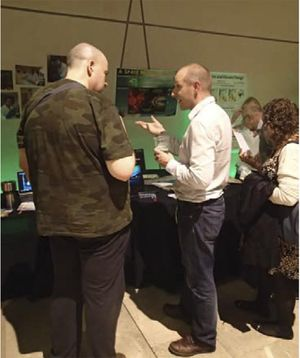
- Working with the UK Met Office Space Weather Operations Centre (MOSWOC) and as part of the Natural Hazards Partnership project, to provide local and planetary magnetic indices and daily forecasts and magnetic data products
- Monitoring and analysis of the geo-electric (telluric) measurements at the UK magnetic observatories
- Maintaining the Monitoring and Analysis of GIC (MAGIC) web tool, in association with National Grid
- Producing the 2015 update of the BGS Global Geomagnetic Model (BGGM), using satellite and other geomagnetic data, including data from all BGS operated observatories
- Delivering geomagnetic observatory data and magnetic field products including daily geomagnetic activity forecasts, to support geophysical survey companies and directional drilling operations, as part of In-Field Referencing (IFR) and Interpolation IFR (IIFR) services
- Providing observatory facilities for calibration and testing of instruments
- Delivering a lecture course to 4th year undergraduates at Edinburgh University on Geomagnetism and to 3rd year students on Planetary Geophysics, including setting and marking of exam questions, running tutorials; and setting and supervising student projects
- Building ‘Raspberry Pi’ magnetometers and rolling out the STFC-funded schools’ magnetometer project, in association with University of Lancaster’s ‘Aurora Watch’ team
- Studying and reporting on the impact of extreme geomagnetic storms on the UK and French transmission systems, in partnership with the Finnish Meteorological Institute, for a customer
- Carrying out a review of the current state of geomagnetic activity forecasting across Europe for ESA, as part of the ongoing ESA Space Situational Awareness (SSA) programme, leading to recommendations on future developments of the SSA Service Coordination Centre
- Preparing for the move of BGS Scotland to the new, purpose built, Charles Lyell Building at Heriot-Watt University in early 2016
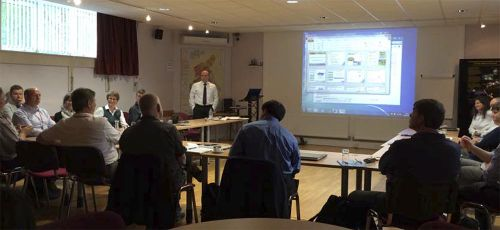
Headline numbers from 2014
Here are some key numbers, which help to put in perspective the team’s outputs as a whole for 2014.
- 598 global oil industry wells supplied with IFR data
- 276 Ordnance Survey map compass references
- 100% (>99%) UK (overseas) observatory data coverage
- 96 magnetic bulletins published
- 75 global oil industry wells supplied with IIFR data
- 42 presentations/posters
- 21 oil industry customer reports
- 20 field set-ups for IFR services
- 12 scientific meetings
- 10 A-to-Z map compass references
- 6 articles on space weather for RIN ‘Navigation News’
- 5 positions on scientific and technical geomagnetism bodies
- 5 public lectures, presentations and demonstrations
- 4 geomagnetic models (WMM2015, 12th generation IGRF candidates, UK reference model, BGGM2014)
- 4 undergraduate projects supervised
- 3 journal and conference proceedings papers
- 3 undergraduate courses taught
- 3 post-doctoral research assistants
- 1 ‘Hypercube’ data set supplied to oil industry
- 1 STFC Public Engagement grant for Raspberry Pi magnetometer
- #1 most-read blog on the BGS ‘GeoBlogy’ site at britgeopeople.blogspot.co.uk/
- 1 observatory tour
- 1 podcast, 1 YouTube video and a number of newspaper and web articles and quotes